2022.07.03.22
Files > Volume 7 > Vol 7 No 3 2022
Effect of material tramadol on some blood components of laboratory rats
1.2Department of Biology, College of Science, Mosul University, Mosul, Iraq
Corresponding author: [email protected] ; [email protected]
Available from: http://dx.doi.org/10.21931/RB/2022.07.03.22
ABSTRACT
The current study deal with the effect of tramadol injections on body weight and some blood components in 40 male laboratory rats, divided into four groups. The first group, G1 represents the control group. The second group G2 and the third group G3 were injected with a concentration of 20 and 40 mg/100 g of body weight, respectively, and the fourth group G4 was injected at a concentration of 80 mg / 100 g of body weight for ten days respectively. The current study results showed a significant decrease in the weights of rats injected with tramadol compared to the control group. Also, there was a significant decrease in the numbers of RBC, PLT, MID#, and GRAN#, respectively. The concentrations of each of the following constants: HGB, HCT, MCV, MCH, and MCHC showed a significant decrease in their values; except for MCV, the decrease was not significant, and the results of this study also recorded a significant increase in the white blood cells count as well as the number of lymphocytes, and there was an increase in both RDW-CV & RDW-SD.
Keywords. Body weight, tramadol, RBC, WBC, PLT.
.
INTRODUCTION
Tramadol is an opioid synthetic opioid analgesic and is chemically trans-2 (dimethyl aminomethyl)-1-(m-methoxyphenyl)- cyclohexanol hydrochloride. It is a centrally acting analgesic, which is used orally or parenterally for including cancer and non-cancer pain also the pain of various other organs, as well as gynecologic and obstetric; it decreases moderate to moderately severe acute or chronic pain1,2,3
the choice of tramadol is affected by the degree of the pain present. It is used parenterally and orally. the analgesic efficacy is attributed to its partial affinity for the mu- opiate receptor and inhibition of norepinephrine and serotonin reuptake; they lower perception and reaction to pain as well as increase pain tolerance 4,5,6,3,7
Tramadol has analgesic activity, which lies between codeine and morphine. It represents about 10- 20 % of the standard morphine 8. It reaches its highest level in the blood after oral administration in about 2 hours; the reason for this is its high oral bioavailability, which is about seventy to eighty percent. Opioids used for analgesia present undesirable effects such as respiratory depression, cardiovascular depression, and sedation. Additionally, to associated with several adverse effects, among which those on the gastrointestinal (GI) tract is most troublesome in terms of frequency and severity Like constipation9,10,5,6 and other Clinical symptoms include abdominal pain, vomiting,gastro-oesophageal reflux, nausea, anorexia, delayed digestion, bloating, straining during intestinal movements, hard stool, and incomplete evacuation9. Most of their effects on gastrointestinal motility and secretion result from suppressing neural activity. Inhibition of gastric emptying, increased sphincter tone, changes in motor patterns, and blockage of peristalsis.11
Tramadol is converted in the liver into O- and N- demethylated five different metabolites by the cytochrome p4505,12, and by-products are excreted through the kidney. The central role of the liver and kidney in detoxification and drug metabolism increases the risks of toxic injury., Further, it may cause hepatotoxicity5 furthermore,
the drugs excreted from kidneys could cause cellular damage leading to kidney dysfunction5,13,12
They pointed out some studies that the term period and high doses of tramadol cause hepatic and renal damage and impotence and increase lipid peroxidation in the rats.14
MATERIAL AND METHODS
Drug uses
Tramadol hydrochloride ampoule ( Trabar- 100 ) was used; each ampoule ( 2ml ) contained tramadol hydrochloride 100 mg ( Mepha company Switzerland ).
Animals
Forty male rats (Rattus norvegicus) weighed between (120-170) grams and were used in this study. The rats were left
in the animal's house for a week before the study, in ideal conditions, natural light 1 dark cycle at 25 + 2 C temperature, and given free access to a balanced diet and water, all over the experimental period.
Experimental design
On the eighth day of the breeding, the Animals were randomly divided into four groups ( 10 rats in each group). The group one (G1 ), the average weight of rats was 153.78 g, served as control and injection doses of saline solution for 10 days. In group two ( G2 ), the average weight of rats was 140 g, and in group three (G3 ), the average weight of rats was 142.5 g, and in group four (G4 ) average weight of rats was 142.9 g. These rats were injected with tramadol HCl at concentrations of 20 mg, 40 mg, and 80 mg/100 g body weight/day for 10 days, respectively14,15
We have calculated doses like El-Gaafarawi (2006) with our modification by adding a concentration of 20mg / 100g of body weight and the period of experiment time was 10 days instead of a month.
The second weight for animals was on the 11th day.
Blood collecting
Blood samples were collected from the eye rats on the 11th day by using an EDTA tube for CBC14,16.
Statistical Analysis
All data are presented as means ± SE. Differences between groups were analyzed by using the Duncan test, one-way ANOVA at the level of statistical significance P _ 0.01 by SPSS version 2116,17
RESULT AND DISCUSSION
Effect of tramadol on body weight
The results showed that tramadol injections to animals showed a significant difference in weight when comparing the weights of animals in the three groups with the control group. But when comparing the weight of each group after tramadol injection with its weight before tramadol injection and separately, there were no significant differences in the weights of those groups, as in Tables (1 and 2). However, there is a percentage decrease in the weight values of the animals of these groups G2, G3, and G4. And in both comparison cases, when compared with the weight value of the control group or with the weight values for each group before the tramadol injection. As shown in Figures (1 and 2).

Table 1. It showed the weight by grams of animals before and after injection by different concentrations of tramadol. For ten consecutive days, when compared with the control group.

Table 2. shows there was no significant difference in the three groups when comparing the weight of rats in grams before injection and after injection with tramadol for ten days.
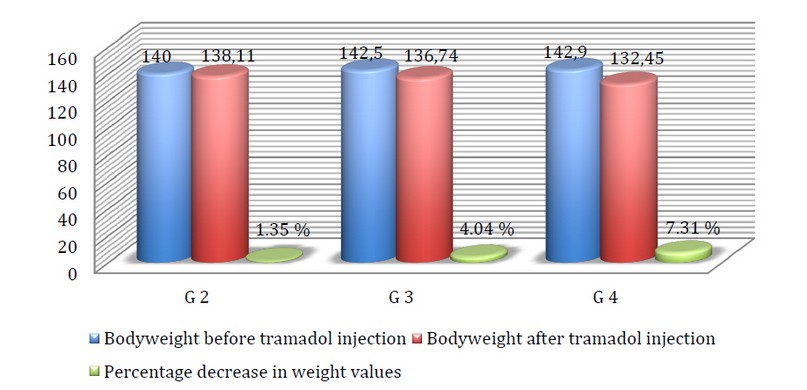
Figure 1. Shows the percentage decrease in the weight values of the G1, G2, G3, and G4 groups. That is when they compare the weight value after injection by tramadol with its value Before injection. For each group separately.
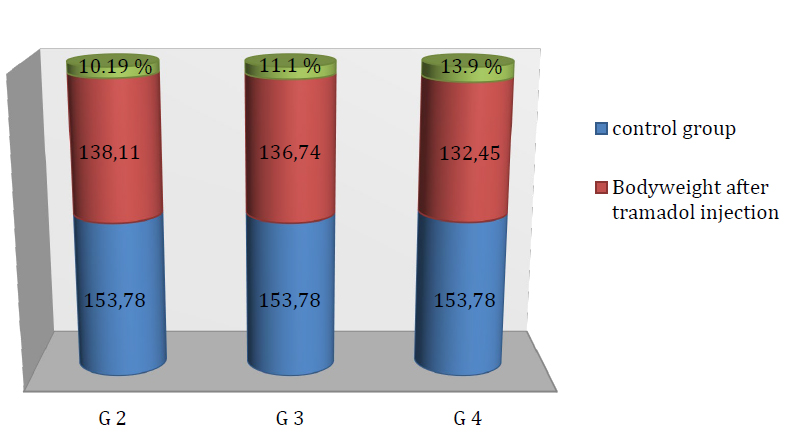
Figure 2. Shows the percentage decrease in the weight values of the G2, G3, and G4 groups. That is when they are comparing the weight value with a control group.
This part of the results agreed with what was found by Udegbunam et al. (2015)6, where giving rodents repeated doses of tramadol led to a decrease in their weight.
The use of such materials in injecting animals leads to diseases. And of course, the result will be many dangerous complications for these injected animals, which are constipation, loss of appetite, abdominal pain, and excessive diarrhea. Such substances show an inhibitory effect on bowel movements and increase muscle tension, cramping, etc. Consequently, weight loss for these animals9,10,6,7.
Effect of tramadol on Hb concentration, PLT, and RBC numbers
The results are shown in Table (3) and Figure (3) that the injecting laboratory animals with such a chemical. It shows changes in the values and concentrations of some blood components, depending on the concentrations used for injection if the total number of red blood cells showed a decrease according to the concentrations used. 80 mg/100 g of animal weight had the highest effect decrease in the number of red blood cells amounting to 4.72 ± 0.23 compared to their numbers in the control group, while the effect decreased at the concentration of 20 mg/100 g of animal weight was 6.2 ± 0.21 compared with the control group 7.61 ± 0.18.
When calculating the percentage decrease in the number of red blood cells for groups G2, G3, and G4 compared to their numbers in the control group, it had found that it reached 38% in the blood of animals for the G4 group, and the percentage was 18.5% for the second group. While the hemoglobin concentration also showed a decrease of (13.36 ± 0.38, 10.2 ± 0.34, and 8.2 ± 0.12) during the different injection concentrations, which are (20, 40, 80) mg/100 g of body weight, respectively, compared with the hemoglobin concentration in the control group. (17±0.39), while the percentage decrease in the value of Hb concentration reached 21.41;40; 51.8) % for each group of 20, 40, and 80 mg/100g of body weight, respectively, when compared with the concentration value of hemoglobin in the control group.
While the number of platelets showed a significant decrease in animals injected with tramadol, the numbers were (402 ± 19.03) at the concentration of 80 mg / 100 g of body weight. And the number of the G2 was reached (692 ± 27.8) compared with numbers in the control group of animals (871.2±31.3). While the highest percentage of decrease in the number of PLT was at a concentration of 80 mg / 100 g of body weight (53.9%), and the lowest percentage of decrease was at G 2, which is (20.57%).

Table 3. Shows the concentration of HGB, total numbers of RBC, and PLT after dosing with different concentrations of tramadol for ten days.
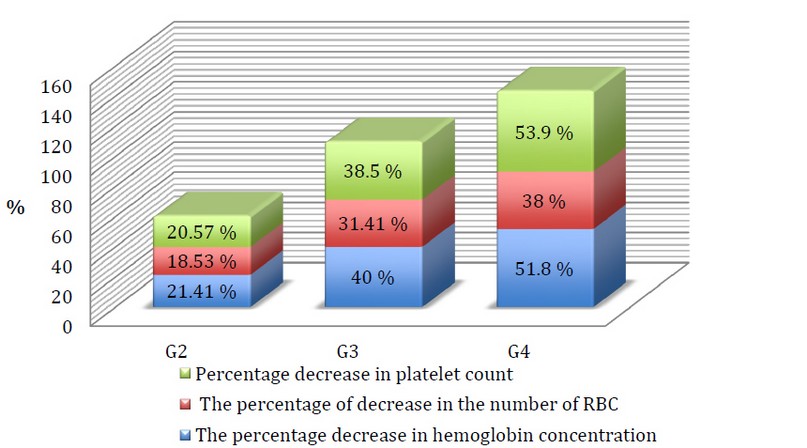
Figure 3. Shows the percentage decrease in HGB, RBC, and PLT values for groups injected with tramadol. When comparing the values of each one of them with the control group.
These results are in agreement with each Elyazji et al.,20138; Aldalou et al., 2014; Nna et al.,201615 and Owoade et al., 2019. The reason may be that the decrease in these blood components, due to the inhibitory effect of tramadol on the morphological differentiation of red blood cells, will affect the rest of the blood components, such as hemoglobin concentration and platelet count. Thus, the amount of energy produced by the metabolic processes in the body will decrease20,21,18,15,19,16. Or it may be due to the adverse effect of the mechanism of blood clotting in the body. In addition, it causes the use of various analgesics such as tramadol, which many studies in this field21,8,18,15,19 have confirmed
The effect of tramadol on the constants of RBC that represent by HCT, MCV, MCH, MCHC, RDW-CV& RDW-SD
The results showed that the concentrations of tramadol injection led to a significant decrease in most of these constants, except for MCV, where the different concentrations of tramadol did not register any significant differences compared with the control group. The 40 and 80 mg / 100 g body weight concentrations recorded significant differences for all the remaining parameters. When compared with the control group. The decrease for these constants is (38.9 ± 0.63; 62.74±0.92; 21.54± 0.71; 34.3± 1.32; 14.6±0.76; 35.0 ± 2.08 ) for HCT, MCV, MCH, MCHC, RDW-CV, RDW-SD, respectively, at the concentration of 20 mg / 100 g of body weight, compared to its concentration in the control group, while the decrease reached for each of HCT, MCV, MCH , MCHC, RDW-CV, RDW-SD at a concentration of 80 mg/100 g of animal weight is (28.9 ± 0.78; 61.23 ± 0.98; 17.37 ± 0.69; 28.37 ± 1.03; 18.5 ± 1.09; 43.5 ± 2.19), respectively, in comparison With their values in the control group for these laboratory-injected animals, which are (49.3 ± 0.53; 64.78±0.58; 22.34±0.35; 34.5± 0.81; 12.0± 0.83; 30.5±1.65) for HCT, MCV, MCH, MCHC, RDW-CV, RDW-SD, respectively. table ( 4 ).
As for the percentage decrease in the values of each of MCV, MCH, MCHC and HCT compared to their values in the control group. This percentage reached (3.15; 3.6; 0.6 ; 21.1) % at G 2for the previous parameters, respectively, and the values for these parameters reached ( 3.9; 12.5; 9.04 ; 34.1) and ( 5.5; 22.25; 17.8 ; 41.4) at concentrations 40 and 80 mg / 100 g of body weight respectively in the blood of these rats.
As for both RDWCV and RDWSD, the results of this research recorded a percentage increase for each of them, following the increase in the concentrations of tramadol used in injections compared to the control group. And the percentage value was an increase in RDW-CV to (17.81; 28.14; 35.14)% for groups injected with concentrations of 20, 40, and 80 mg / 100 g of body weight, respectively. As for the RDW-SD, the percentage value increase was (29.9%) at the concentration of 80 mg / 100 g of body weight. As for each of the concentrations of 40 and 20 mg / 100 g of body weight, the percentage was (23.6 and 12.9), respectively, as in Figure (5).

Table 4. Shows the concentrations of (HCT, MCV, MCH, MCHC, RDW-CV, and RDW-SD) for the three groups injected with different concentrations of tramadol for ten days.
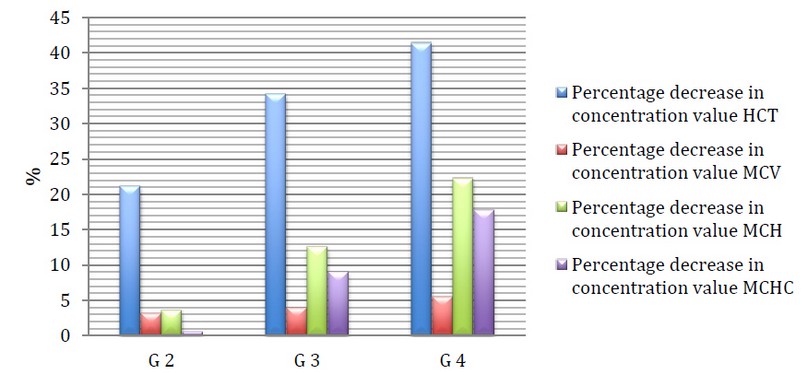
Figure 4. Percentage decrease in the concentration values of HCT, MCV, MCH, and MCHC for groups injected with tramadol compared to values of their concentrations in the control group.
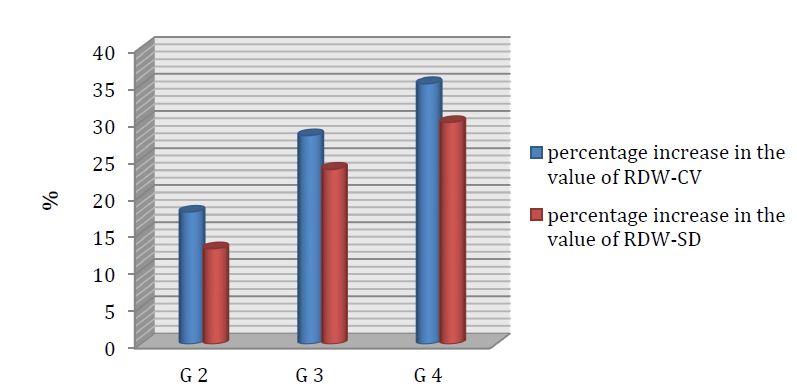
Figure 5. This shows the percentage increase in the value of (RDW-CV, and RDW-SD) for groups injected with tramadol compared to their values in the control group.
The results of this research are consistent in the agreement of the decrease in the concentrations of (HCT, MCV, MCH, MCHC) with what was found by Nna et al., ( 2016 )8. The decrease in HCT is consistent with both Costa et al., ( 2013)21 & Jiang et al., (2014 ) & Aldalou et al., ( 2014 ) & Aldiwan et al., (2015 ).
The reason for the decrease in the volume of HCT may be due to the effect of this substance tramadol on the decrease in the activity or function of the sympathetic nerve during blood circulation in the spleen and thus will affect the volume of HCT22,23,15,19. In addition to a decrease in hemoglobin concentration, this will lead to the inhibition of the biosynthesis of iron in the bone marrow, and this will subsequently affect MCH and MCHC8,18,15,19 Or because when the animal is injected with tramadol, HCT will decrease due to the transfer of bodily fluids from parts outside the blood vessels to the inside of the blood vessels, and many studies confirmed this in this field21,8,22,15 Or it could be the reason raised anti-diuretic hormone and aldosterone secretion with resulting water and salt retention causes the expansion of the extracellular fluid leading to hemodilution and drop in HCT6.
The effect of tramadol on the WBC ;LYM%;MID% ;GRAN% ;LYM# ;MID# &GRAN#
The indication of the results shown in Table (5) and Figures (6 and 7) that injections with different concentrations of 20, 40, 80, and mg/100 gm of body weight have an effect on the immune system, of the injected animals through the increase and decrease in the total numbers of white blood cells and they are the other types. The increase in the number of white blood cells was (10.13 ± 0.43; 12.95 ± 0.47; 15.3 ± 0.9) respectively for the above concentrations compared with its number in the control group (9.84 ± 0.27). While the increase in the numbers of lymphocytes and LYM % reached (14.03 ± 0.73; 89.95 ± 1.31), respectively, at the concentration of 80 mg / 100 g of animal weight compared to the control group (7.1 ± 0.53; 72.16 ± 0.91). but the numbers of MID# and GRAN# were showed a significant decrease in the three groups injected with different concentrations of tramadol compared with the control group, which reached (0.99 ± 0.04; 1.75 ± 0.19) for each one parameter, respectively. where their numbers were at a concentration of 80 mg/ 100 g of animal weight were (0.57 ± 0.03; 1.0 ± 0.08) for MID# and GRAN#, respectively, and the numbers of MID# reached (0.65 ± 0.04; 0.64 ± 0.03) at concentrations of 20,40 mg/100 g of animal weight, respectively.
The numbers of GRAN# cells were (1.47 ± 0.12; 1.45 ± 0.123) for concentrations of 20 and 40 mg/100 g of animal weight, respectively. MID% and GRAN% also significantly decreased in all groups injected with tramadol. When they compared to the control group. Which reached (10.06 ± 0.49 ; 17.78 ± 0.77) for each of MID% and GRAN%, respectively. While the values of each of them at the concentration of 20 mg/100 g of animal weight were (6.5 ± 0.28; 14.4 ± 0.47). The value of GRAN% decreased to (6.4±0.22; 11.2±0.37) at concentrations of 80 and 40 mg/100g of animal weight, respectively. As for the MID% also decreased to (3.65 ± 0.21) in the G4 rats and reached (4.94 ± 0.22) in the G3 group.
While the percentage increase in the values of white blood cell counts, LYM# and LYM%, which is (35.68; 19.77; 14.03)% at the concentration of 80 mg/100 g of body weight, and the percentage increase in the values of the above parameters reached (2.86; 8.77). ; 11.4)%, respectively, at the concentration of 20 mg / 100 g of body weight, when comparing the values of the above parameters with their values in the control group. As for the percentage decrease values of both GRAN% and GRAN# for each group G 2, G 3, G 4, that reached {(37.01; 17.14), (19.01; 15), (64; 42.9 )} % , respectively. By comparing their values with the values of the control group. In addition, the percentage of decrease in MID% value was (63.72; 50.9; 35.39)% at concentrations 80, 40, and 20 mg/100g of animal weight. The percentage of decrease in the value of MID# at the concentration of 80 mg/100 g of animal weight was (42.42) %. And the percentage decrease reached (35.35%) and (34.34) % for each of G3 and G2, respectively.

Table 5 . Shows the values of WBC, LYM%, MID%, GRAN%, LYM#, MID#, and GRAN# for the three groups injected with tramadol for ten days.
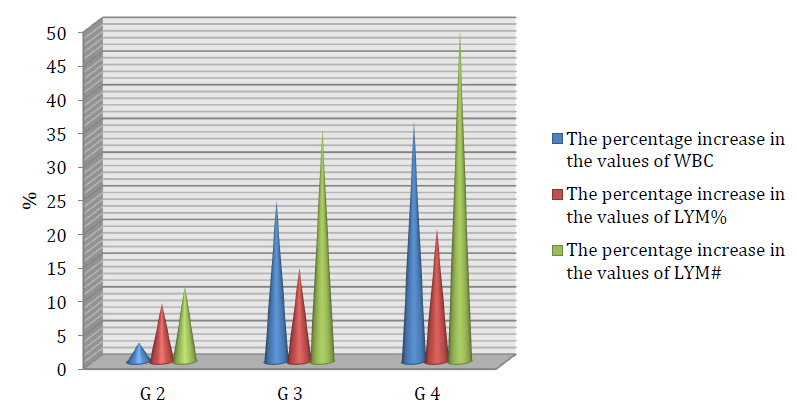
Figure 6. The percentage increase in WBC, LYM%, and LYM# values when comparing their values in the control group.
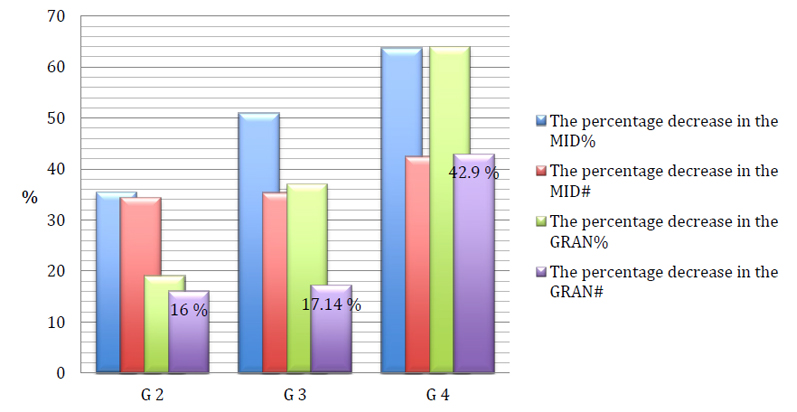
Figure 7. The percentage decrease in MID%, MID#, GRAN% and GRAN# when comparing their values in the control group.
These results are inconsistent ( conflicting ) with Costa et al. ( 2013) & Nna et al. (2016). As for the high numbers of white blood cells and LYM%, this part of the results agree with both Elyazji etal. (2013) & Aldiwan et al., (2015). It also agrees with what was found by Tsai and Won, 2001, that tramadol led to an increase in LYM%, and also consistent with what was found by Aldalon et al., 2014 where it was found that tramadol led to an increase in the white blood cells count.
The difference in the number of diverse white blood cells may be due to the activation of the defense mechanism of the immune system in rats, and thus will affect the white blood cells and induce them to form a positive response by monocyte and lymphocyte in addition to the increase in the WBC, which was the result of lymphocytes, This is one of the main features of variance in white blood cell counts
The difference in the number of diverse white blood cells may be due to the activation of the defense mechanism of the immune system in rats, and thus will affect the white blood cells and induce them to form a positive response by monocyte and lymphocyte in addition to the increase in the number of white blood cells, which was the result of lymphocytes, This is one of the main features of variance in white blood cell counts21,8,2,15,16. Or it may be due to the effect of this substance tramadol on the differentiation of white blood cells as a positive response to survival due to the immune response of the cells of animals treated with tramadol4,8,22,23,18,2,19,24.
CONCLUSIONS
This study showed that daily use of tramadol for a relatively short period in young rats leads to significant changes in all blood components, especially hemoglobin, red blood cell count, and differentiation. As well as its disorders in the immune system. And the number of blood platelets affects the process of blood clotting. In addition to negatively affecting body weight, which may cause future growth disorders.
ACKNOWLEDGEMENT
The authors wish to express their gratitude to the University of Mosul, College of Science, Biology department, for their provided facilities, which helped improve this work's quality.
Source of Funding: Self-Funding.
Conflict of Interest
The authors declare that they have no conflict of interest in this study.
REFERENCE
1. Upadhyay D K , Palaian S, KishoreP V , Paudel R, Prabhu M, Shankar P R, and Mishr p. Drug Review- Tramadol. Journal of the Institute of Medicine,2006; 57–61.
2. Aldiwan M A, Alzobidy A M H and Younis M A .The Effect of Tramadol on Some Blood and Biochemical Parameters of Male Rats (Rattus Norvegicus) .Baghdad Science Journal .2015; 12(3), 496–502.
3. Hussein S A , Abdel Aal S A and Ismail H K. Effect of Tramadol Drug on Some Biochemical and Immunological Parameters in Albino Male Rats; Evaluation of Possible Reversal Following Its Withdrawal. BENHA VETERINARY MEDICAL JOURNAL2017 ;33(2),418–429.
4. LI L , DONG J, LU D , SHENG JIANG , JIANG S, LIN D and FAN H. EFFECTS OF ILETAMINE-ZOLAZEPAM-XYLAZINE-TRAMADOL COMBINATION ON BIOCHEMICAL AND HAEMATOLOGICAL PARAMETERS IN CATS. Bull Vet Inst Pulawy.2012; 56,369–372.
5. Elmanama A A, Abu Tayyem N E S, Essawaf H N and Hmaid I M. Tramadol-Induced Liver and Kidney Toxicity among Abusers in Gaza Strip, Palestine. JJBS Jordan Journal of Biological Sciences.2015; 8(2),133–137, doi:10.12816/0027559.
6. Udegbunam R I, Okereke H N and Udegbunam S O. Single versus Repeated Tramadol Injection in Laparotomized Albino Rats: Comparison of Effects on Hematology, Serum Biochemical Parameters, and Body Weight Gain. J. Adv. Vet. Anim. Res.2015; 2(3),316–320, doi:DOI: 10.5455/javar.2015.b100.
7. Zebedee L O, Jeremiah O N, Soroh A E and Agoro E S . Haematological Presentations in Acute and Chronic Tramadol Intoxication. Toxicol Forensic Med Open J.2020;5(1 ),26–36, doi:10.17140/TFMOJ-5-134.
8. Elyazji N R, Abdel-Aziz, Aldalou A and Shahwan O. The Effects of Tramadol Hydrochloride Administration on the Hematological and Biochemical Profiles of Domestic Male Rabbits. IUG Journal of Natural and Engineering Studies.2013; 21(2), 51–65.
9. HOLZER P. New Approaches to the Treatment of Opioid-Induced Constipation. European Review for Medical and Pharmacological Sciences.2008; 12(1),119–127.
10. Leppert W.The Impact of Opioid Analgesics on the Gastrointestinal Tract Function and the Current Management Possibilities. Wspolczesna Onkol 2012;16(2),125–131, doi:10.5114/wo.2012.28792.
11. Khansari MR , Sohrabi M R and Zaman F. The Useage of Opioids and Their Adverse Effects in Gastrointestinal Practice: A Review. Middle East Journal of Digestive Diseases.2012; 5(1),5–16.
12. Al-Mashhadane F A , Ismail H Kh and Al-Saidya A M. Histopathological Effects of Chronic Use of Tramadol on Liver and Kidney in Sheep Model. Journal of Pharmaceutical Sciences and Research.2019; 11(6),2208–2212.
13. Ali O K , Ahmed AJ S and Al-Graibawi M A A. Effects of Tramadol on Histopathological and Biochemical Parameters in Male Rabbits. American Journal of Biology and Life Sciences.2015; 3(3),85–90.
14. El-Gaafarawi I I. Biochemical Toxicity Induced By Tramadol Administration In Male Rats. The Egyptian Journal of Hospital Medicine.2006; 23,353–362.
15. Nna V U, Oka V O, Udefa A L, Ofutet E O and Ofem O E . High Doses of PDE5 Inhibitors and Tramadol Reversibly Alters Haematological Parameters in Rats. Journal of Applied Pharmaceutical Science.2016; 6(4), 086–092, doi:10.7324/JAPS.2016.60412.
16. Al-Hayali H. Effect of Hypervitaminosis D3 on Liver, Kidney Functions in White Rats. INTERNATIONAL JOURNAL OF RESEARCH IN PHARMACEUTICAL SCIENCES.2020; 11( 2 ),5691–700, doi:10.26452/ijrps.v11i4.3212.
17. Mohammed M I, Yousif S W and Rabeea M A . Physiological and Biochemical Changes Analysis to Labors Blood Samples in Plastics Recycling Factory in Mosul-Iraq. Journal of Global Pharma Technolog.2018; 10(6),281–288.
18. Aldalou A R , Abdel-Aziz I and Shahwan O . IMPACT OF GIVING SILDENAFIL (VIAGRA) / TRAMADOL (TRAMAL) COMBINATION ON THE BLOOD OF DOMESTIC RABBITS. Journal of Science.2014; 4( 3 ),162–169.
19. Owoade A O, Adetutu A and Olorunnisola O S. Hematological and Biochemical Changes in Blood, Liver and Kidney Tissues under the Effect of Tramadol Treatment. Journal of Alcoholism & Drug Dependence.2019; 7(2 ), 1–7.
20. Dehkordi S H, Sadegh A B ,Abaspour E, Brojeni N B, Aali E and Sadeghi E . Intravenous Administration of Tramadol Hydrochloride in Sheep: A Haematological and Biochemical Study. Comparative Clinical Pathology.2012; 21(3),289–293.
21. Costa P F, Nunes N , Belmonte E A, Moro J V and Lopes P C F. Hematologic Changes in Propofol-Anesthetized Dogs with or without Tramadol Administration. Arq. Bras. Med. Vet. Zootec.2013; 65(5), 1306–1312.
22. Jiang S , Fan HG , Lu DZ , Hou JL , Song XD , Wang Y and Wang HB . Effects of the Tiletamine/Zolazepam-Xylazine-Tramadol Combination on Plasma Oxidative Status and Haematological Indicators in Miniature Pigs. ACTA VET. BRNO .2014; 83,145–149, doi:10.2754/avb201483020145.
23. Akhtardanesh B , Sharifi H, Rasooli R and Aghazamani M.Evaluation of Haematological and Biochemical Changes after Short Term Tramadol Usage in Healthy Dogs. Iranian Journal of Veterinary Medicine .2014; 8(1), 41–45.
24. Tsai Y C and Won S J. Effects of Tramadol on T Lymphocyte Proliferation and Natural Killer Cell Activity in Rats with Sciatic Constriction Injury. Pain.2001; 92(1), 63–69, doi:10.1016/S0304-3959(00)00472-3.
Received: 19 March 2022/ Accepted: 15 February 2022/ Published:15 Agoust 2022
Citation: Ramírez M, Debut A, Alexis F, Rodríguez J. Control of vibriosis in shrimp through the management of the microbiota and the immune system. Revis Bionatura 2022;7(3) 22. http://dx.doi.org/10.21931/RB/2022.07.03.1
